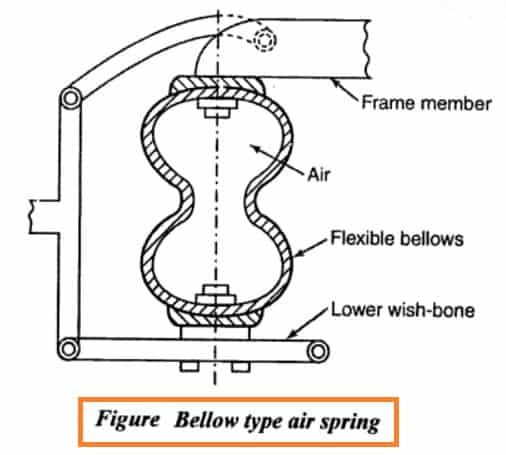Air suspension systems are an automotive technology used to control the height of a vehicle’s suspension. This system uses air pressure in the tires to compress or decompress the shock absorbers, which in turn raises or lowers the vehicle.
The automatic air suspension system is a technology that has been around for quite some time. It uses an electro-hydraulic control valve to lower and raise the vehicle’s ride height.
In air suspension systems, air springs are utilized. Air suspension systems are installed and configured differently for various makes and models, but the fundamental concept is the same. The factory spring is removed, and an airbag, sometimes known as an air spring, is installed or manufactured to replace it. The suspension may be changed up or down when air pressure is provided to the airbag (lifted or lowered).
a spring of airs are flexible bellows that hold compressed air and are used to bear the weight on automobiles. They are typically constructed of textile-reinforced rubber. The bellows are inflated by the air pressure, which lifts the chassis away from the axle. When squeezed, air springs exhibit flexibility or “springiness.” It’s found on a lot of today’s heavy-duty vehicles, trailers, and buses.
Also see: Air Brake System: Parts, Functions, Diagram, Principle, and Benefits.
Air springs have the following characteristics:
1. They are soft when the vehicle is not loaded, but stiffen as the weight rises due to increased air pressure within the chamber. As a result, whether the vehicle is little loaded or completely loaded, it provides the best ride comfort. 2. Whenever there is a load fluctuation, the vehicle’s height is maintained by changing the air pressure. 3. By absorbing road stress, air springs improve vehicle stability. 4. Air spring systems are engineered to provide maximum load bearing capacity, stability, and overall ride quality.
There are many different types of air springs.
There are three main kinds of air springs available.
- the twisted, double-convoluted
- the tapered-sleeve, an elongated sleeve
- the sleeve-rolling
The double-convoluted design resembles two tiny tyres stacked on top of each other. These air springs have a higher load capacity, a shorter stroke, and a more progressive spring rate, making them ideal for most front suspensions where the spring lies far inboard of the suspension’s load point. As a result, load capacity needs are multiplied while travel requirements are divided.
Air springs with a tapered or rolling sleeve have a smaller diameter, a longer stroke, and a more linear spring rate. Because they have greater travel needs and less load-capacity requirements, they are best suited for most back-end applications.
In air spring suspensions, devices for regulating air pressure and compressors for compressing air are needed. Small, electric, or engine-driven air compressors are often used in these systems, which may fill an on-board air receiver tank that reserves compressed air for immediate use in the future. The suspension system, on the other hand, is more complicated. In contemporary cars, electronically modulated air suspension is used in conjunction with air springs.
Air suspension comes in a variety of shapes and sizes.
Based on the kind of air spring utilized, the following are the many types of air suspension systems.
- Air suspension in the bellows style
- Air suspension with pistons
- Air suspension with elongated bellows
I Air suspension of the bellows type (Spring):
Rubber bellows make up this kind of spring. For optimal working, the bellows are formed into circular portions with two convolutions, as illustrated in Figure. As a result, the coil spring is replaced with a bellow type air suspension.
air spring with bellows
(ii) Air suspension with pistons (Spring):
A metal-air container in the shape of an inverted drum is used in this spring. The frame is attached to the drum. The lower wishbone is linked to a sliding piston. A flexible diaphragm is used to create a seal. As illustrated in Figure, the diaphragm is firmly linked to the drum lip at its outside circumference and to the piston at its center.
 air spring with a piston
air spring with a piston
(ii) Air spring with elotlgated bellows:
Elongated bellows are utilized when this suspension system is applied to the vehicle’s rear axle. These bellows are roughly rectangular in form, but they have semi-circular ends with two convolutions in general. These elbows are located between the vehicle’s rear axle and the frame. Radius rods are utilized at the rear axle to withstand torques and thrusts.
 air spring with enlarged bellows
air spring with enlarged bellows
Air Suspension System (A.S.S.) is a kind of (Air Suspension System):
Air Suspension System Diagram:
 Diagram of an air suspension system
Diagram of an air suspension system
Air Suspension System Components:
The following are the components of the air suspension system:
- Filter for the air
- Accumulator of Air
- Valve of relief
- Air spring
- Control valve for the lift
- The return valve is a device that allows you to
- Line of Supply
Air Suspension Suspension Suspension Suspension Suspension Suspension
Figure 1 depicts the architecture of an air suspension system. The four air springs, which may be bellows or piston-type, are placed in the same location as the coil springs. An air compressor, air accumulator, relief valve, lift control valve, leveling valve, and pipeline are also included.
Air Suspension Operation:
An air compressor compresses ambient air via a filter to approximately 240 MPa, at which pressure the air in the accumulator tank, which is also equipped with a safety release valve, is maintained. As illustrated, the high-pressure air passes via the lift control valve and the leveling valves before reaching the air springs. Each air spring is inflated with compressed air to sustain the vehicle’s weight. When the wheel hits a bump in the road, the air compresses even more and absorbs the stress.
What Is The Difference Between An Air Suspension And A System of Rigid Suspension?
| Air Suspension System | Rigid Suspension System |
|---|---|
| 1. Air springs or air bellows are utilized in this method. | 1. Leaf springs, coil springs, or both are utilized in this system. |
| 2. In an air suspension system, automated control mechanisms regulate wheel deflection. | 2 There is no automated control device in this system. |
| 3. Improved ride comfort and lower noise levels. | 3 Riding comfort is inferior than that of an air suspension system. |
| 4. When compared to traditional springs, the springing rate changes considerably less between loaded and unladen situations. | 4. When compared to an air suspension system, the springing rate is higher. |
| 5. As the deflection rises, so does the system’s stiffness. | 5. As the deflection increases, the system’s stiffness diminishes. |
| 6. Uses: Volvo buses, high-end automobiles | 6. Heavy and medium-duty vehicles, as well as passenger automobiles, are examples of applications. |
| 7. Driver and passenger tiredness is reduced. | 7. When compared to the air suspension system, the driver and passenger experience more tiredness. |
| Compressor, reservoir, leveling valve, air springs or air bellows, and other components are included. | It is made up of leaf springs, coil springs, shock absorbers, shackle joints, brackets, and other components. |
Benefits of air suspension include:
The following are some of the benefits of air suspension: 1) The automated control mechanisms make the best use of a changeable space for wheel deflection. 2) Changes in head light alignment due to changing loads are avoided since the vehicle height is also constant. 3) When compared to a typical steel spring, the spring rate changes considerably less between loaded and unladen situations. The dynamic loading is reduced. 4) Air springs provide a higher level of ride comfort and noise reduction, which lowers driver and passenger fatigue.
Air Suspension System Disadvantages:
The following are some of the disadvantages of using an air suspension system:
- Initial investment is more expensive.
- Takes up more room.
- The expense of upkeep is higher.
- Because of the absence of friction damping, road shocks need it.
The use of an air suspension system is as follows:
For a more comfortable ride, air suspension is utilized in Modern Buses, Volvo, passenger vehicles, and trucks.
Thorat, Sachin
Sachin is a Mechanical Engineering B-TECH graduate from a reputable Engineering institution. He is now employed as a designer in the sheet metal business. He is also passionate in Product Design, Animation, and Project Design. He also enjoys writing articles about mechanical engineering and uses his creative project ideas, design, models, and videos to inspire other mechanical engineering students.
Recent Articles
link to Slotter Machine – Types, Parts, Operations, Diagram, Specification link to Hydraulic Seals – Definition, Types, Diagram, Function, Failure, Application
{“@context”:”https://schema.org”,”@type”:”FAQPage”,”mainEntity”:[{“@type”:”Question”,”name”:”How much does air suspension cost?”,”acceptedAnswer”:{“@type”:”Answer”,”text”:”
The cost of air suspension is $5,000.”}},{“@type”:”Question”,”name”:”Is air suspension worth the money?”,”acceptedAnswer”:{“@type”:”Answer”,”text”:”
Yes, air suspension is worth the money.”}},{“@type”:”Question”,”name”:”What is the purpose air suspension?”,”acceptedAnswer”:{“@type”:”Answer”,”text”:”
Air suspension is a system that uses air pressure to keep the car on the ground. This allows for smooth driving at low speeds, and also helps with fuel economy.”}}]}
Frequently Asked Questions
How much does air suspension cost?
The cost of air suspension is $5,000.
Is air suspension worth the money?
Yes, air suspension is worth the money.
What is the purpose air suspension?
Air suspension is a system that uses air pressure to keep the car on the ground. This allows for smooth driving at low speeds, and also helps with fuel economy.
Related Tags
- air suspension system pdf
- air suspension system price
- disadvantages of air suspension system
- air suspension system diagram
- air suspension system working principle

